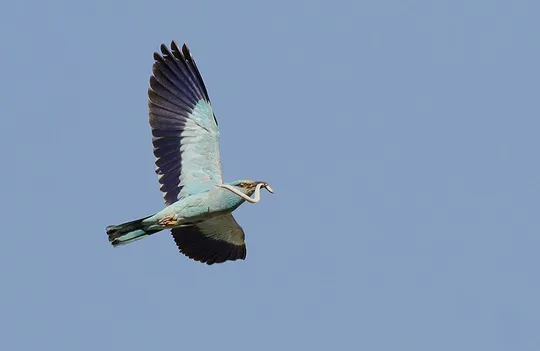Coracias garrulus
 Vulnerable
Vulnerable






| Breeding In Israel | Breeder |
|---|---|
| Migration Types | Long Range |
| Zoographical Zones | Mediterranean, Irano-Turanian |
| Landscape Types | Mountainous, Plains & Valleys, Wide Wadis, Cliffs, Rural Area |
| Vegetation Types | Mediterranean Maquis, Mediterranean Garrigue, Steppe |
| Vegetation Densities | Medium, Low |
| Nest Locations | Cliffs, Mountainside |
| Diet Types | Invertebrate |
| Foraging Grounds | Ground |
| Body Sizes | Small (up to 500g) |
| Threat Factors | Pesticide Poisoning, Tree planting, Habitat loss and fragmentation |
The size and form of the European Roller resemble a “small corvid”, such as a Jackdaw, and its raucous calls are similar to a raven. Its plumage is sky-blue, except for its back that is chestnut brown. In flight, it displays a prominent wing pattern, with turquoise blue coverts, contrasting with dark blue-black primary feathers. Flight is nimble, with relatively slow, strong rhythmic wingbeats.
A summer breeder in the Golan Heights, the Northern Valleys, the Jordan Valley, the Judean Lowlands and the Northern Negev, and a relatively common migrant throughout Israel. Its main nesting concentrations at present are in the southern Golan Heights, the Jordan Valley and the northwestern Negev. Until the 1960s, it was very common throughout Israel’s Mediterranean region, but then its population declined sharply due to pesticide poisoning (Shirihai 1996, Paz 2013). In the 1980s, the population was estimated at 500-1,000 pairs, but since then the species has receded from most of the Galilee, Carmel, Judea and Samaria and the Coastal Plain, and its current population estimate is 500 pairs at the most.
The European Roller breeds in Southern, Central and Eastern Europe, east to Central Asia (Kazakhstan and Western China). All its populations winter in Africa south of the Sahara. In Europe, there have been severe declines in population sizes but on a global scale, the species is still classified as Least Concern (LC).
No specific conservation measures have been taken for this species to date.
- פז, ע. 1986. עופות. מתוך אלון, ע. (עורך), החי והצומח של ארץ ישראל. כרך 6. הוצאת משרד הביטחון, ישראל.
- Mendelssohn, H. 1975. Report on the Status of Some Bird Species in Israel in 1974. I.C.B.P. 12:265-270.
- Shirihai, H., 1996. The Birds of Israel. Academic Press, London.
- Symes, A. 2013. Species generation lengths. Unpublished, BirdLife International.
- Species page at Birdlife International
Current Occupancy Map
| Data Missing | Sporadic | Limited Sites | Low Density | High Density |
|---|---|---|---|---|
| 0 | 0 | 0 | 0 | 0 |
Distribution maps
The maps presented here provide visual information on the distribution of species in Israel from the past and present, and the changes in occupancy and breeding density during the comparison period. For further reading
Relative Abundance 2010-2020
Breeding density values in the current decade as determined from experts' opinion and observations from databases.
| Data Missing | Sporadic | Limited Sites | Low Density | High Density |
|---|---|---|---|---|
| 8 | 12 | 12 | 21 | 19 |
Relative Abundance 1980-1990
Density values based primarily on the book The Birds of Israel (Shirihai 1996).
| Data Missing | Sporadic | Limited Sites | Low Density | High Density |
|---|---|---|---|---|
| 5 | 14 | 14 | 17 | 22 |
Occupancy 1990-2020
The map shows differences in the species breeding distribution between the 1980's breeding map and the current weighted breeding evaluation. Negative value - species previously bred in the grid and is not presently breeding; positive value - species has not previously bred in the grid and is currently breeding.
| Data Missing | No Change | Occupancy Increase | Occupancy Decrease |
|---|---|---|---|
| 6 | 35 | 1 | 9 |
Change in Relative Abundance 1990-2020
The map shows the changes in the relative abundance of a species in each of the distribution grids between the breeding map of the 1980s and the weighted current breeding evaluation. Negative values - decline in abundance; positive values - increase in abundance; zero - no change in abundance.
| 80 to 100 | 50 | 20 to 30 | No Change | 30- to 20- | 50- | 100- to 80- | Data Missing |
|---|---|---|---|---|---|---|---|
| 0 | 4 | 2 | 22 | 12 | 14 | 11 | 16 |
| Rarity | |
|---|---|
| Vulnerability | |
| Attractiveness | |
| Endemism | |
| Red number | |
| Peripherality | |
| IUCN category | |
| Threat Definition according to the red book |
 Contributed:
Contributed: 





